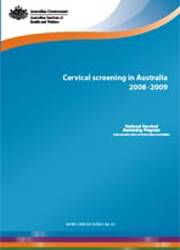Summary
The National Cervical Screening Program (NCSP) aims to reduce cervical cancer cases, as well as illness and death resulting from cervical cancer in Australia, through an organised approach to cervical screening. It achieves this through detecting and treating high-grade abnormalities before any possible progression to cervical cancer.
The NCSP operates as a joint program of the Australian and state and territory governments, targeting women aged 20–69 years.
The following statistics refer to the latest data available for women aged 20–69 years.
How many women were diagnosed with, or died from, cervical cancer?
In 2007, the incidence of cervical cancer remained at its historic low of 9 new cases per 100,000 women, with mortality at 2 deaths per 100,000 women. Incidence and mortality have both halved since the introduction of the NCSP in 1991.
The incidence of cervical cancer in Aboriginal and Torres Strait Islander women was more than twice that of non-Indigenous women, and mortality of Aboriginal and Torres Strait Islander women was 5 times the non-Indigenous rate.
How many women participated in the National Cervical Screening Program?
In the 2-year period 2008–2009, more than 3.6 million women participated in the NCSP. This was 59% of eligible women.
Participation was highest in Major cities and Inner regional areas and lower in more remote areas, though with less than 2.5 percentage points separating the highest participation of 59% in Major cities from the lowest of 57% in Remote areas.
Participation showed greater differences across socioeconomic status of residence, and a clear trend of increasing participation with increasing socioeconomic status from 53% of women residing in areas of lowest socioeconomic status to 64% of women in areas of highest socioeconomic status.
Participation by Aboriginal and Torres Strait Islander women is not available, although there is evidence that this population group is under screened.
How many women rescreened early or after a reminder letter?
Only 15% of women with a negative Pap test result rescreened earlier than recommended, indicating that relatively few women rescreen more often than required.
Of the women sent a 27-month reminder letter by a cervical cytology register in 2008, 32% rescreened within 3 months, indicating that this letter acts as a prompt for many women.
How many high-grade abnormalities were detected?
In 2009, for every 1,000 women screened, 8 women had a high-grade abnormality detected by histology, providing an opportunity for treatment before possible progression to cancer.
For women aged less than 20 years, this decreased between 2004 and 2009 from 15 to 9.



